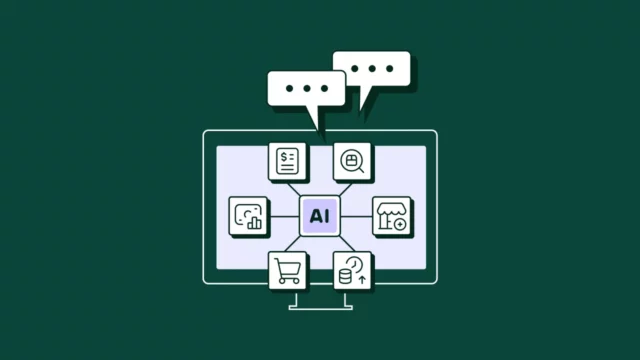The Benefits of Implementing AI in Procurement Management

The Benefits of Implementing AI in Procurement Management
Artificial intelligence (AI) has swiftly become central to successful and efficient business operations, including those of procurement and vendor management. By integrating AI in procurement, teams can improve supplier selection, facilitate better purchasing decisions, conduct more comprehensive contract and vendor lifecycle management, and optimize supply chain operations.
AI accomplishes these efficiency feats by ingesting, categorizing, and analyzing huge amounts of data to provide meaningful insights. These insights help procurement leaders identify trends, predict needs, and develop cost-saving strategies. AI tools can even provide tailored guidance during the product selection and purchasing processes, ensuring buyers stay within budget constraints and meet volume discount requirements.
Let’s look at how AI tackles procurement’s biggest challenges to deliver maximum cost efficiency and continuous improvement in purchasing and procurement management.
Join us for an upcoming live conversation: register for ChatP2P: AI & the Back Office today
Why procurement teams are turning to AI to overcome cost and supplier challenges
AI helps teams overcome procurement challenges by identifying the best suppliers, automating time-consuming tasks, and predicting market trends. This reduces manual errors, speeds up procurement operations, and drives cost-effective purchasing decisions. Moreover, AI's data-driven insights enable businesses of all sizes to mitigate supplier risks and optimize spend management.
Rising supply costs
Inflation and higher production costs mean procurement teams must become more protective of the bottom line. As prices for materials and goods increase, companies face tighter margins and heightened financial pressures. Tariffs further complicate supply pricing calculations. Order.co helps address these costs by considering price, logistics, and tariff impacts in its price analysis.
AI technology acts as a crucial ally by offering predictive analytics to forecast price trends and identify alternative suppliers or products that meet quality requirements but cost less. Additionally, AI-driven tools enhance negotiation capabilities by providing real-time market insights, helping procurement teams secure more favorable terms and manage indirect spend increases.
Third-party risk management
External vendor risk poses a significant concern for procurement teams, as it can lead to supply chain disruptions, compromised quality, and increased costs. AI technology plays a pivotal role in mitigating these potential risks by facilitating thorough vendor risk assessments.
By leveraging vast databases and predictive analytics, AI can identify possible red flags and compliance issues early on. This allows procurement organizations to make informed decisions, ensuring robust supplier performance and reliability while minimizing exposure to third-party vulnerabilities.
Logistics concerns
Shipping and geographic concerns significantly impact procurement speed and efficiency, influenced by transportation costs, delivery timelines, and regional regulations. Long distances can hinder cycle times and inflate expenses, while regulatory disparities complicate compliance.
AI technology alleviates these challenges by optimizing route planning, improving demand forecasting, and automating customs documentation processes. Its predictive capabilities identify the most efficient transport methods and potential bottlenecks, ensuring timely deliveries and a smooth supply chain despite geographical complexities.
Scalability challenges
Manual procurement makes it difficult to keep up with the volume of transactions and invoices flowing through most businesses. Relying on outdated methods slows decision-making and limits access to critical insights. Technology makes it far easier to respond to market changes and scale the procurement function as your business grows.
AI enhances the benefits of intelligent procurement software, making it easier to automate processes, analyze datasets from different data sources, and provide actionable insights for strategic sourcing and negotiations. With machine learning capabilities, AI-powered tools can continuously refine their efficiency, improving product targeting and increasing contract compliance.
7 Ways AI technologies solve procurement’s biggest challenges
Procurement strategies are constantly changing, growing, and evolving alongside the rest of operations. AI enables this growth, helping businesses source, negotiate, and manage their supply chains more efficiently.
From automating mundane tasks to providing strategic insights, here are seven ways AI technologies address procurement's thorny challenges and help teams create more value for their efforts.
1. Strategic sourcing
AI leverages internal spend data, historical data, and broader pricing benchmarks to identify the best suppliers for your business needs. Rather than simply searching for the lowest price, AI-powered platforms use machine learning to examine past purchases with similar content or context—such as previous orders of toner and printer—evaluating options based on cost, delivery time, tariff impacts, and existing volume agreements. This enables procurement teams to make data-driven decisions quickly and effectively, enhancing overall efficiency. It also allows teams to take advantage of available discounts, such as percentage-based savings tied to purchasing volume.
2. Purchase approvals
Dynamic workflows are key to timely and effective invoice approval. AI tools can intelligently route approvals to the appropriate stakeholders based on predetermined parameters like budget limits, departmental needs, and authority levels. This ensures all purchase agreements get attention and approval according to purchasing policies and departmental requirements. Well-managed and fully detailed approvals accelerate decision-making while minimizing supplier risk and maverick spending.
3. Invoice processing management
AI excels at process automation tasks like invoice management. With an AI tool, procurement can automate repetitive tasks like purchase order and receipt matching and reconciliation. AI technology leverages algorithms to identify discrepancies, prevent duplicate invoices, and ensure accurate and timely processing. Using AI in procurement and AP operations reduces human error and enhances efficiency, allowing teams to focus on strategic tasks rather than manual data entry.
4. Risk mitigation
Procurement carries inherent risks, which grow as purchasing volume and complexity increase. By standardizing procurement processes and detecting anomalies indicative of fraud, AI mitigates common pitfalls like supplier noncompliance, quality problems, and data security issues. AI's ability to ingest and monitor vendor and contract information and transactions against data points offers teams a smoother, more risk-aware AI procurement process that empowers operations and improves financial performance.
5. Spend analysis
Technology helps procurement teams overcome the inefficiencies and inconsistencies of spreadsheet-based spend analysis. Processes that previously took hours and yielded varying value now provide efficient insights into spending patterns, cost-saving opportunities, and future trends. Since AI analyzes vast amounts of data in real time, procurement professionals can use it to gain granular insights into end-to-end procurement for more informed decision-making.
6. Payment automation
AI-driven payment automation transforms the way businesses manage their finances. By intelligently scheduling payments to optimize cash flow, it ensures funds are allocated efficiently, preventing late fees and capitalizing on early payment discounts. This strategic planning approach maximizes cash efficiency while strengthening supplier relationships, creating a stable and reliable procurement ecosystem.
7. Budgets and forecasting
Using the context already present in procurement data, AI can leverage advanced analytics to project future financial scenarios with high accuracy. It can help finance and procurement teams analyze past spending patterns, assess contracts against benchmarks and market trends, and evaluate company performance to forecast revenues and expenses. Procurement automation with AI allows for more precise budget allocation and proactive financial planning, reducing the risk of unforeseen shortfalls and enabling businesses to strategize effectively for growth and stability.
How leading procurement teams are using AI: Real-world examples and best practices
The most compelling use cases for implementing AI in procurement are the real-world results of teams who rely on it to reduce costs and improve operations. Let’s look at one company enjoying tangible benefits and savings from AI-powered procurement.
AvantStay is a vacation rental platform with a lot of order complexity. The company manages over 2,300 vacation rental properties across 140 cities, meaning manual procurement and logistics aren’t a viable option. To maintain smooth operations and a strong customer experience for all its vacation properties, AvantStay uses advanced software with AI technology.
A few integral AI features help the company stay ahead of changes and challenges while maintaining full control and visibility, including:
- Substitutions and stockout protection: Customers expect similar products and quality when visiting hospitality locations. With potential shortages and fluctuations in product availability, AvantStay needed a way to ensure consistency without manually chasing down new vendors or placing rush orders to meet demand. AI-powered search automatically finds and suggests identical or similar products when primary vendors are out of stock.
- Enhanced order compliance: Managing consistency in product offerings requires a considerable degree of organization. The AvantStay team accomplishes this by using approved product lists tailored to different rental properties. With the contextual capabilities of AI, buyers can quickly replenish needed items that align with properties’ curated lists, saving time on reorders and maintaining confidence in the quality of what they buy.
- Centralized high-volume order management: As the number of locations grows, it becomes more difficult to maintain accurate procurement across the business. AI keeps up with this complexity, regardless of how many locations or departments the AvantStay team supports. This centralized approach ensures accuracy, streamlines workflow management, and offers dynamic scalability to meet future needs.
The benefits of AI are evident in the cost savings companies achieve with the right platform. For AvantStay, using an AI-driven procurement management tool helped the company save $190,000 in under three years.
Generative AI in procurement: The next level of cost & supplier optimization
Gen AI provides tailored data analysis tools and workflow automation, enabling teams to make faster, more cost-effective choices. Beyond improving operational efficiency and visibility, teams can realize measurable ROI by implementing AI procurement tools.
- Procurement cost savings: The most straightforward presentation of ROI is the money you save each year by using AI to inform purchasing decisions. You can demonstrate cost savings as a percentage of overall expenses or the reduction in budgets compared to the cost of implementing procurement software.
- Reduction in manual processing costs: Automating routine procurement tasks decreases time and labor costs associated with manual operations. Teams can illustrate this ROI through saved wage hours on manual procurement.
- Enhanced supplier negotiation outcomes: AI-driven analytics tools provide deep insights into supplier performance and market dynamics, empowering procurement teams with the data quality necessary to secure better pricing and terms. You can show this value via the percentage of savings achieved through negotiation and volume discounts.
- Improved spend visibility: AI tools offer real-time tracking of expenditures across organizations, providing more accurate budgeting, financial planning, and opportunities to demonstrate budget compliance and cost reduction.
- Inventory management and optimization: AI solutions can analyze demand patterns to optimize stock levels, reducing excess inventory costs and the risk of stockouts. Procurement can highlight savings from streamlined relationship management, reduced SKU redundancy, and decreased shipping costs resulting from replacing stockouts.
Power savings and scalability with AI in procurement
Choosing a robust procurement management tool with AI capabilities is the surest way to maximize cost efficiency and value creation within the procurement function. Next-generation tools help streamline the purchasing process and leverage advanced data analytics for fully informed vendor selection, negotiation, and strategic sourcing. These capabilities transform procurement into a value-add rather than a cost center.
Order.co provides the right balance of strong, guided procurement features and proprietary AI models to help procurement professionals strengthen their bottom line, profitability, and vendor relationships. Schedule a demo of Order.co to learn how to take advantage of these AI-powered features.
Get started
Schedule a demo to see how Order.co can simplify buying for your business.
"*" indicates required fields



